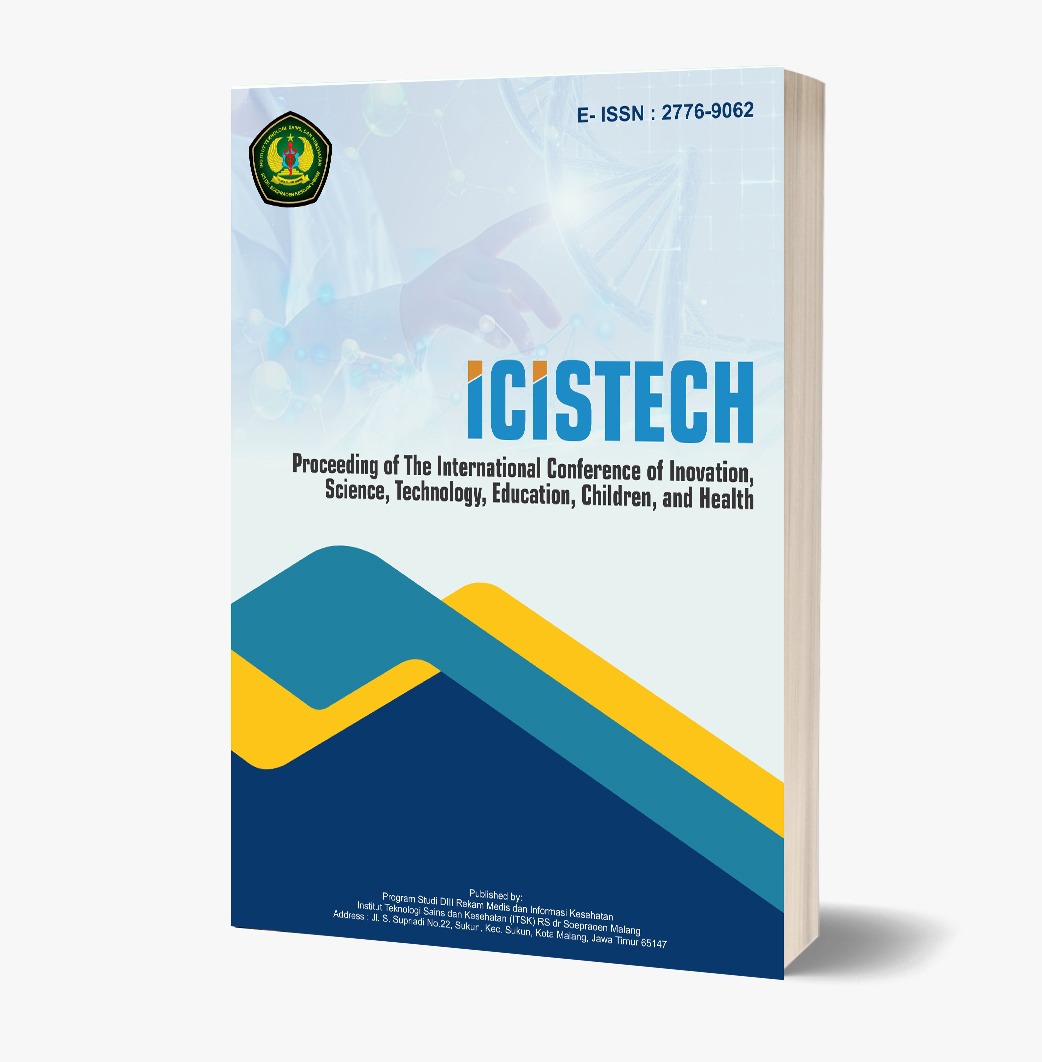Relationship Between Pregnant Mothers' Nutritional Status and the Event of Malnutrition in Babys
DOI:
https://doi.org/10.62951/icistech.v5i1.246Keywords:
Maternal Nutrition, Stunting, ToddlersAbstract
The nutritional status of pregnant women, assessed using the Upper Arm Circumference (LILA), plays a crucial role in fetal growth and birth outcomes. Inadequate maternal nutrition can lead to low birth weight, which increases the risk of stunting a condition characterized by a height-for-age (TB/U) less than -2 SD. Stunting is associated with a fourfold increase in child mortality under five years old, highlighting its significant impact on public health. This quantitative case-control study aimed to examine the relationship between maternal nutritional status during pregnancy and the incidence of stunting in toddlers. The study was conducted from August 25, 2024, to January 24, 2025, at Gogagoman Health Center in Kotamobagu City. A total of 60 toddlers participated, with 30 stunted toddlers (case group) and 30 non-stunted toddlers (control group). Data were collected through self-administered questionnaires, medical records, and microtoise measurements. The study employed univariate and bivariate data analysis, using a chi-square test to explore the association between maternal nutritional status and stunting incidence. The results indicated that the majority of respondents had adequate (non-KEK) maternal nutritional status. Specifically, 40% of mothers in the stunted group were classified as non-KEK, while 83.3% of mothers in the non-stunted group were in the same category. A statistically significant association was found between maternal nutritional status and the incidence of stunting, with a p-value of 0.010. These findings underscore the importance of improving maternal nutrition to prevent stunting and its associated risks. The study recommends collaborative efforts between health centers and local governments to provide targeted nutrition education and support for pregnant women and women of reproductive age, aiming to reduce stunting incidence and improve child health outcomes.
References
Akbar, R. R., Kartika, W., & Khairunnisa, M. (2023). The effect of stunting on child growth and development. Scientific Journal, 2(4), 153-160. https://doi.org/10.56260/sciena.v2i4.118
Aldisurya, A. A., Akhriani, M., Wati, D. A., & Dewi, A. P. (2023). Relationship between pre-pregnancy body mass index (BMI), number of pregnancies, and number of nutrition education participation with circumference upper arm (LILA) of pregnant women. Indonesian Journal of Health Research and Development, 1(2), 32-38. https://doi.org/10.58723/ijhrd.v1i2.99
Apriliyanti, R., & Kustriyanti, D. (2023). Children growth and development of 18 months-aged babies: Nutritional status overview for early stunting screening. Jurnal Smart Keperawatan, 10(1), 37. https://doi.org/10.34310/jskp.v10i1.709
Aryani, A., Herawati, V. D., Mufidah, N., & Eriyanti, E. (2024). The effect of health education on nutrition on increasing mothers' knowledge in preventing stunting in children. 2(1). https://doi.org/10.36728/iceete.v2i1.167
Astuti, F. D., Azka, A., & Rokhmayanti, R. (2022). Maternal age correlates with stunting in children: Systematic review. Journal of Maternal and Child Health, 7(4), 479-448. https://doi.org/10.26911/thejmch.2022.07.04.11
Fibriana, A. I., Budiono, I., Pribadi, F. S., & Kasmini, O. W. (n.d.). Factors influencing cognitive development in early childhood: A systematic literature review. 9-22.
Ismail, F., Fasrini, U. U., & Harmen, A. P. (2024). Nutritional status and cognitive development in children aged 2-5: A narrative review.
Kurnia, Y. (2023). Correlation between nutritional status of mothers during pregnancy and stunting incidence at the age of 24-59 months at Godean Health Center 1. Jurnal Kebidanan, 12(1), 61-68. https://doi.org/10.26714/jk.12.1.2023.61-68
Lestari, E., Siregar, A., Hidayat, A. K., & Yusuf, A. A. (2024). Stunting and its association with education and cognitive outcomes in adulthood: A longitudinal study in Indonesia. PLoS ONE, 19(5), 1-18. https://doi.org/10.1371/journal.pone.0295380
Maskur, S. U., Budiman, B., & Lestari, A. (2021). The relationship between knowledge and dietary habit with incidence chronic energy deficiency in the pregnant women in the working area Talise City of Palu. International Journal of Health, Economics, and Social Sciences (IJHESS), 3(1), 19-27. https://doi.org/10.56338/ijhess.v3i1.1423
Morales, F., Montserrat-de la Paz, S., Leon, M. J., & Rivero-Pino, F. (2024). Effects of malnutrition on the immune system and infection and the role of nutritional strategies regarding improvements in children's health status: A literature review. Nutrients, 16(1), 1-16. https://doi.org/10.3390/nu16010001
Mulianingsih, M., Nurmayani, W., Pratiwi, A., Rifky, N., & Safitri, H. (2021). Nutritional status and weight of pregnant women to birth weight (BBL) to early detection of stunting. STRADA Jurnal Ilmiah Kesehatan, 10(1), 138-150. https://doi.org/10.30994/sjik.v10i1.523
Ningrum, E. W., & Cahyaningrum, E. D. (2020). Estimation model on newborn anthropometry based on mid-upper arm circumference (MUAC). Jurnal Kebidanan Dan Keperawatan Aisyiyah, 16(1), 120-125. https://doi.org/10.31101/jkk.1486
Prasetyo, Y. B., Wardojo, S. S. I., & Laksono, A. D. (2024). Factors influencing children's dietary variety in Eastern Indonesia: A comprehensive national analysis. Jurnal Keperawatan Padjadjaran, 12(3), 308-315. https://doi.org/10.24198/jkp.v12i3.2488
Putri Adila, W., Sri Yanti, R., & Sriyanti, R. (2023). The relationship of chronic energy deficiency (CED), exclusive breastfeeding, and economic with stunting in Nagari Aua Kuning West Pasaman. Science Midwifery, 10(6), 2721-9453.
Romey, R., & Mangunsong, D. (2025). Stunting and its implications on cognitive ability and language development. 10, 134-147. https://doi.org/10.26911/jepublichealth.2025.10.02.01
Roseboom, T. J. (2019). Epidemiological evidence for the developmental origins of health and disease: Effects of prenatal undernutrition in humans. Journal of Endocrinology, 242(1), T135-T144. https://doi.org/10.1530/JOE-18-0683
Roswita, K. W., & Nurbaniwati, N. (2022). The correlation between anemia and chronic energy deficiency in pregnant women with the incidence of low birth weight at the Ciwaringin Cirebon Health Center in 2020-2022. 382-390. https://doi.org/10.24198/obgynia.v7i3.751
Safitri, N. I., Noor, N. N., Wahiduddin, Amiruddin, R., Jafar, N., Balqis, & Mallongi, A. (2023). Risk factors of stunting in children aged 0-23 months in Katumbangan Health Center, Indonesia. Pharmacognosy Journal, 15(5), 851-855. https://doi.org/10.5530/pj.2023.15.163
Soliman, A., De Sanctis, V., Alaaraj, N., Ahmed, S., Alyafei, F., Hamed, N., & Soliman, N. (2021). Early and long-term consequences of nutritional stunting: From childhood to adulthood. Acta Biomedica, 92(1), 1-12. https://doi.org/10.23750/abm.v92i1.11346
Sopiah, M. (2022). Early childhood development (physical, intellectual, emotional, social, moral, and religious tasks) implications for education. Indonesian Journal of Early Childhood: Jurnal Dunia Anak Usia Dini, 4(2), 361. https://doi.org/10.35473/ijec.v4i2.1674
Sutami, I. (n.d.). Nutrition education on family-based food and knowledge on feeding practices of mothers of children Agricultural Extension and Communication Study Program, Faculty of Agriculture, Sebelas Maret. 36, 1548-1556.
Tyarini, I. A., Menga, M. K., Setiawati, A., & Daiyah, I. (2025). The effect of nutritional status of pregnant women on the incidence of stunting in early childhood: Determinants of growth and development. 24-31. https://doi.org/10.61099/junedik.v3i1.71
Widya Addiarto, & Yulia Rachmawati Hasanah. (2023). Study investigation the risk factors of toddlers with low nutritional status in the North Coast of Java, Indonesia. Jurnal Kesehatan Dr. Soebandi, 11(2), 107-112. https://doi.org/10.36858/jkds.v11i2.508
Widyayanti, A., Dewie, A., & Silfia, N. N. (2025). Determinants of chronic energy deficiency (CED) in pregnant women in the Lere Health Center working area, Palu City in 2021-2023. 17(1), 1-10. https://doi.org/10.36456/1dzp9q54
Downloads
Published
How to Cite
Issue
Section
License
Copyright (c) 2025 Proceeding of The International Conference of Inovation, Science, Technology, Education, Children, and Health

This work is licensed under a Creative Commons Attribution-ShareAlike 4.0 International License.













